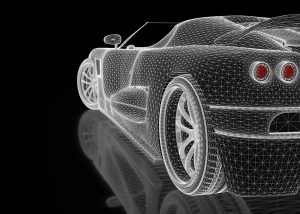3D scanning is one way to build a 3D model. Recall that the 3D model can be built without the use of 3D scanner – a professional program for working with three-dimensional graphics. But the 3D scanner greatly facilitates and speeds up this process.
is one way to build a 3D model. Recall that the 3D model can be built without the use of 3D scanner – a professional program for working with three-dimensional graphics. But the 3D scanner greatly facilitates and speeds up this process.
3D laser scanners are devices that analyze the physical object, and, based on the data obtained, create a 3D model. Three-dimensional image 3D scanner stores mainly in STL, OBJ, PLY and WRL formats.
With 3D scanner, you can quickly and accurately reproduce the most accurate object model. The work of the 3D scanner must be controlled by an experienced engineer. The scan result is refined in a professional graphic editor for 3D graphics. In the future, if necessary, you can carry out 3D-printing of the object, based on the built 3D model.
Three-dimensional scanning methods:
- pin 3D scanner. To scan the device, you need to be in direct contact with the scan object;
- contactless 3D scanner. Getting a 3D model with it is considered the most promising 3D scanning method. The 3D scanner does not necessarily have to contact the subject, which allows 3D scanning for inaccessible objects, cultural and architectural monuments, as well as jewelry. Already there is an industrial 3D scanner that crawls buildings, embankments and other large objects:
– Active non-contact 3D scanners (for studying the object using a structured light or laser beam, which, falling on the object, is reflected and based on this display, the 3D scanner builds the 3D model);
– Passive non-contact 3D scanners (this type uses an already existing reflection from the object, mainly sunlight).
The general advantages of 3D scanners:
1. Highest precision of the model – the 3D scanner reproduces even small, small, details of the physical object;
2. High speed – the bulk scan lasts only a few minutes, and sometimes seconds, after which it is necessary to complete the 3D-model built by the scanner in professional 3D graphics programs;
3. The scanner can be placed at different angles, depending on the complexity of the object, and the object itself can not be touched, which is especially important when scanning large and huge objects (for example, houses, monuments and landscapes).
Contact 3D scanners:
- easy to use;
- do not depend on the level of lighting;
- create high-precision models;
- The 3D model file is small in scope.
Contactless 3D scanners:
- energy-saving;
- do not need direct contact with the object;
- apply technology of structured light;
- Do not damage the physical object.
Using a 3D scanner
– Engineering analysis – 3D scanner can quickly and qualitatively create a three-dimensional model of the object and calculate its physical proportions in the required sizes. In the presence of a physical model in a single instance, bulk scanning will help create multi-dimensional copies and quickly set up small-scale production.
– Digital analysis – 3D scanner helps to visualize all technical discrepancies between products and parts, and therefore make the necessary adjustments before the product is manufactured.
– Digital archiving. Now you can abandon two-dimensional drawings, drawings and even 3D-modeling outdated details. The 3D scanner reads all the necessary information from the object, builds the 3D model and archives it in the required format for the production. This significantly save time and does not require the allocation of space for storage of physical drawings.
– Architecture. With the 3D scanner, you can create a model of the whole home, as well as individual elements of architecture: emblems, columns and various kinds of scenery.
– Medicine – The 3D printer itself is an excellent helper for 3D scanning of bones and even individual organs – with the highest level of detail! In the future, the resulting 3D models and prototypes can be used as educational materials in specialized universities or for the creation of complete biological prosthetics.
Image credit: TayebMEZAHDIA
